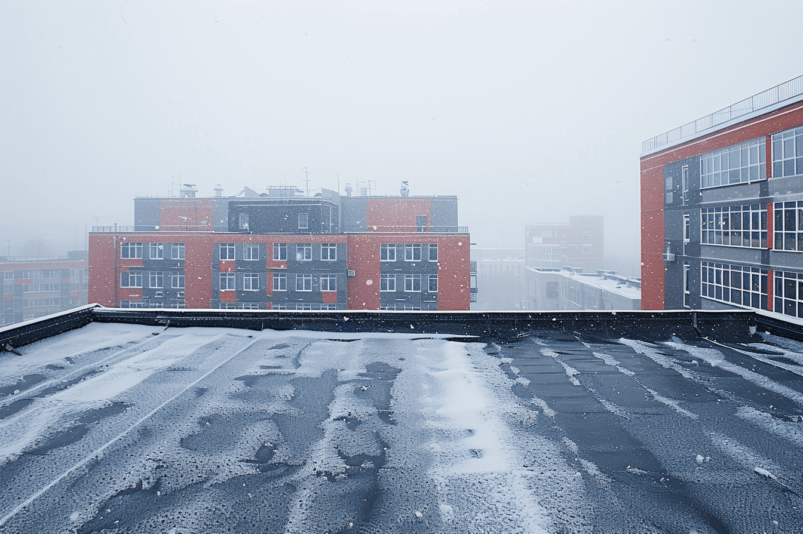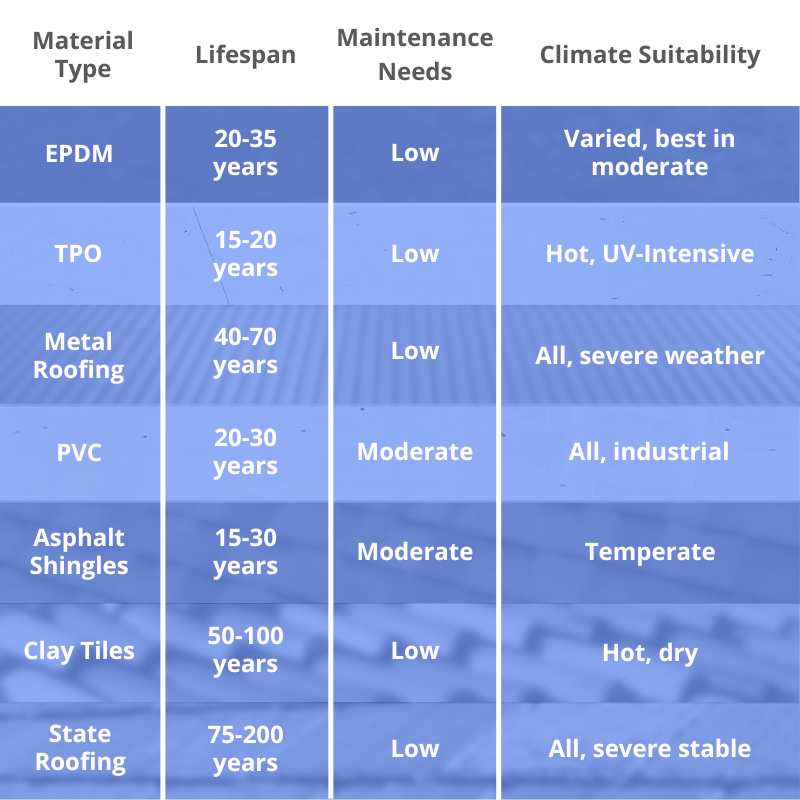
As much as we would like it to be, choosing the right roofing material is much more than just about aesthetics. It’s also about longevity, maintenance, and your local climate. Each of the materials we’re covering below has unique advantages and suitability for specific situations. From the economical asphalt shingles to the nearly indestructible slate, we’ll explore what makes each option stand out.
Lifespan Breakdown

How Long Does an EPDM Roof Last?
EPDM (Ethylene Propylene Diene Monomer) is a synthetic rubber roofing material, well-regarded for its durability, with a typical lifespan of 20-35 years. It’s particularly favored for flat commercial roofs in a variety of climates.
- Cost Effectiveness: EPDM offers a competitive initial cost and low long-term maintenance, making it a cost-effective option for extensive roofing needs. Its durability reduces the frequency of replacements, adding to overall savings.
- Climate Suitability: EPDM excels in both cold and moderate climates due to its excellent resistance to UV rays, ozone, and extreme temperature variations. For hotter climates, white EPDM, which reflects sunlight, can be used to enhance energy efficiency.
- Installation and Adaptability: The material’s flexibility and availability in large sheets allow for quick and versatile installation options. EPDM can be fully adhered, mechanically attached, or ballasted, which provides adaptability to various roof configurations and designs.
How Long Does a TPO Roof Last?
TPO (Thermoplastic Polyolefin) is a popular choice for those seeking a reflective roofing solution, with lifespans typically ranging from 15 to 20 years. It’s ideal for roofs where energy efficiency is a priority, particularly in warmer climates.
- Cost Effectiveness: TPO is valued for its energy-saving properties due to its UV-resistant white surface, which helps reduce cooling costs. While the installation might be on par or slightly higher than EPDM, the savings in energy costs make it a favorable option over time.
- Climate Suitability: With its excellent reflective properties, TPO is best suited for hot climates where reducing heat absorption is crucial. It helps maintain cooler building temperatures, decreasing the burden on air conditioning systems.
- Maintenance and Repair: TPO roofing requires minimal maintenance due to its mold growth resistance and ability to handle thermal expansion and contraction well. The seam strength of TPO roofs is generally stronger than that of EPDM, which decreases the likelihood of leaks.
How Long Does a PVC Roof Last?
PVC (Polyvinyl Chloride) roofing is a robust option known for its longevity and resistance to environmental factors, with lifespans generally between 20-30 years. It’s especially suitable for buildings with heavy chemical exposures or where fire resistance is crucial.
- Cost Effectiveness: PVC can be a more expensive option upfront but offers significant durability and chemical resistance, which can lead to lower long-term costs, especially in industrial settings.
- Climate Suitability: PVC performs well in a range of climates. Its heat-welded seams create a strong bond that withstands thermal contraction and expansion well, making it effective in both hot and cold environments.
- Installation and Adaptability: Installation of PVC roofing is straightforward due to its lightweight and flexibility. PVC can be mechanically attached, fully adhered, or ballasted, allowing it to adapt to different roof layouts and designs.
How Long Does a Metal Roof Last?
Metal Roofing encompasses materials such as steel, aluminum, and copper, offering a lifespan of 40-70 years. Metal is highly durable and is an excellent choice for both residential and commercial buildings that face extreme weather conditions.
- Cost Effectiveness: The initial cost of metal roofing is higher than some materials, but its longevity and minimal maintenance requirements make it a cost-effective choice over time. Additionally, it can increase a property’s resale value due to its durability and aesthetic appeal.
- Climate Suitability: Metal roofing is exceptional in areas with severe weather, including heavy snow, hail, and wind. Its interlocking panels provide excellent protection and stability.
- Installation and Adaptability: Metal roofs offer versatility in design with a variety of colors and styles. They require professional installation to ensure proper fitting and to maximize their lifespan, but once installed, they can be one of the most hassle-free roofing options available.
How Long Does an Asphalt Shingle Roof Last?
Asphalt Shingles are one of the most common roofing materials in residential areas, known for their cost-effectiveness and a lifespan that typically ranges from 15 to 30 years. They are particularly favored for their versatility in aesthetics.
- Cost Effectiveness: Asphalt shingles are among the most affordable roofing options on the market, making them a popular choice for homeowners looking for a balance between price and performance.
- Climate Suitability: While versatile, asphalt shingles perform best in temperate climates. They can degrade faster under severe temperature fluctuations and extreme weather conditions.
- Installation and Adaptability: Asphalt shingles are relatively easy to install and can be adapted to different architectural styles, making them suitable for a wide range of homes. They come in a variety of colors and styles, allowing customization to fit the aesthetic of almost any building.
How Long Does a Clay Tile Roof Last?
Terracotta Tiles are distinguished by their exceptional durability and distinctive style, often found in Mediterranean, Spanish, and Southwestern architecture, with lifespans that can sometimes exceed 100 years!
- Cost Effectiveness: While clay tiles come with a higher initial investment, their longevity and minimal maintenance requirements can make them a cost-effective solution over time.
- Climate Suitability: Clay tiles are particularly effective in hot, dry climates. Their ability to withstand high temperatures and resist decay from UV exposure makes them ideal for areas like the Southwest United States.
- Installation and Adaptability: Due to their weight, clay tiles require a sturdy structural base and professional installation. They offer less adaptability compared to lighter materials but excel in regions where their thermal properties and aesthetics are highly valued.
How Long Does a Slate Roof Last?
Slate Roofing combines elegance and longevity, ideal for those looking for a roof that makes a statement and lasts generations. Often associated with historical and upscale properties, slate’s durability is unparalleled, with lifespans extending from 75 to even 200 years, depending on the softness.
- Resilience in Any Climate: Its natural resilience makes slate suitable for various climates, excelling particularly in areas prone to severe weather—resisting high winds, heavy rain, and snow with ease.
- High Initial Investment, Lifelong Value: The upfront cost of slate is on the higher end, but considering its minimal upkeep and potential to outlast several generations, it proves economical over decades.
- Expert Installation Required: The weight and handling of natural stone require expert installation techniques. While slate may not offer a wide range of styles, its timeless appeal and the unique character of each tile add significant architectural value to any property.
Which One is Best for Your Situation?
After considering their lifespans, maintenance needs, cost-effectiveness, and suitability for your climate, which one have you landed on? Each roofing material offers unique benefits and challenges, certainly. Regardless, you should think about your own cycle as well. Meaning, you should ask yourself how long you plan to be at this location, what weather conditions are like, and the like. This will put you on the right track early on.





